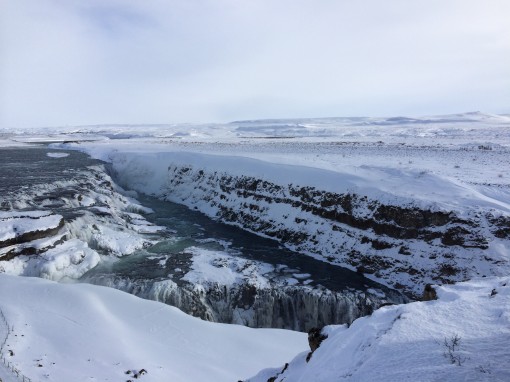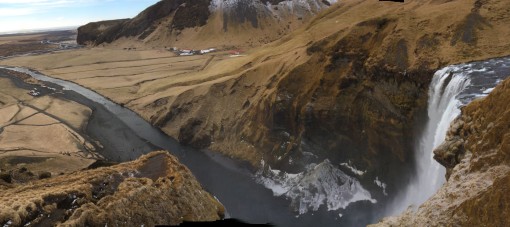This is a great series of maps (explaining the Middle East and really showing what Vox is all about. I learned quite a bit from it. It may sound silly but it also helped me realize how interrelated the various timelines, histories and events covered in high school really affected the world we have today. Learning “European history” seemed so distant from modern day events but these maps and explanations helped some things “click” back together for me.

Our Trip to Iceland
Rachel and I spent four days in Iceland and I wanted to share our experiences and photos.
March 19, 2014
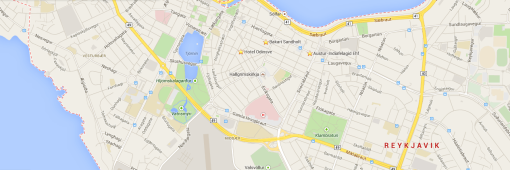
We flew out from Boston at 7:30 PM Eastern and arrived in Keflavik around 7 AM GMT. The funniest thing we learned upon arrival was you then simply go and buy duty-free alcohol with (literally) everyone from your flight, attendants included. Everything in Iceland is amazingly expensive so you buy things as cheaply as you can.
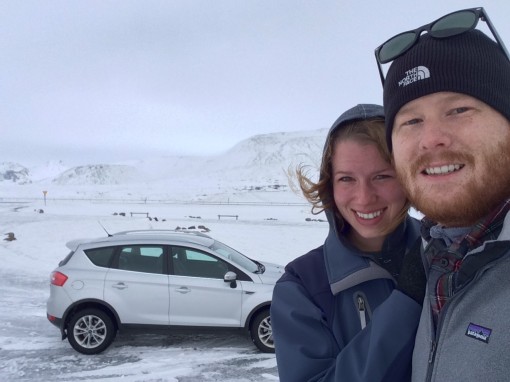
After picking up our rental car and GPS we drove the 50 KM or so along the coast to Reykjavik. Over 2/3 of the country’s population lives in the city and even at rush hour, there’s really not much traffic.
 Once we arrived at our hotel, Hótel ÓÐINSVÉ, we parked on the street and checked in. Since our room wasn’t ready at 8 in the morning we headed over to Reykjavík Roasters for a quick “pick me up” and a light morning snack. At this point Rachel suggested we grab our swim suits and find a nearby pool to do as the locals do. We walked a few blocks (everything is only a few blocks away) to Sundhöll Reykjavíkur and took a shower, changed out of our “airplane” clothes and enjoyed the hot, geothermal water.
Once we arrived at our hotel, Hótel ÓÐINSVÉ, we parked on the street and checked in. Since our room wasn’t ready at 8 in the morning we headed over to Reykjavík Roasters for a quick “pick me up” and a light morning snack. At this point Rachel suggested we grab our swim suits and find a nearby pool to do as the locals do. We walked a few blocks (everything is only a few blocks away) to Sundhöll Reykjavíkur and took a shower, changed out of our “airplane” clothes and enjoyed the hot, geothermal water.
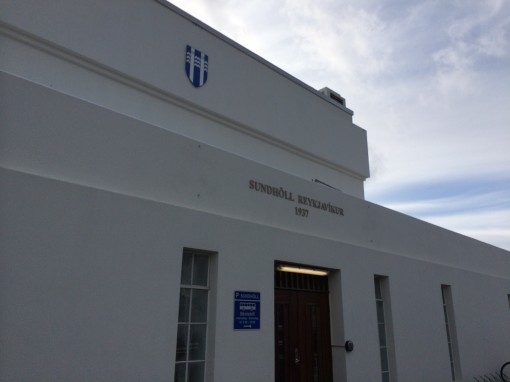
We then grabbed lunch at one of the most famous restaurants in Iceland, Bæjarins beztu — it’s a hot dog stand with delicious lamb-based links, a sweet mustard, and crunchy fried onions. From there we spent time walking around town and visited the capital’s park and lake, Tjörnin, which includes some of the few trees in the country.
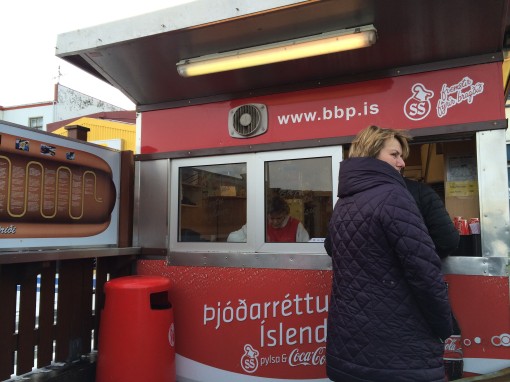
Around 2 or 3 PM we were getting really tired and napped. After a few hours of rest we walked a few blocks (again) to likely the country’s best Indian restaurant, Austur India Fjelagid. We had a great meal to end the day, all thanks to the recommendation from Andrew’s inside.co travel guide.
March 20, 2014
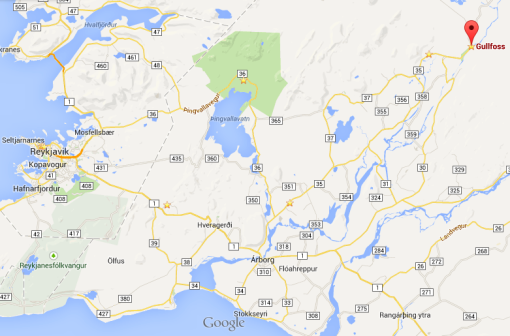
The next morning we woke up refreshed and without much jet lag. We gathered all our materials, maps, and guides, and planned our route around the Golden Circle. After enjoying a European-style breakfast buffet (with fresh salmon) at the restaurant connected to the hotel we hit the road.
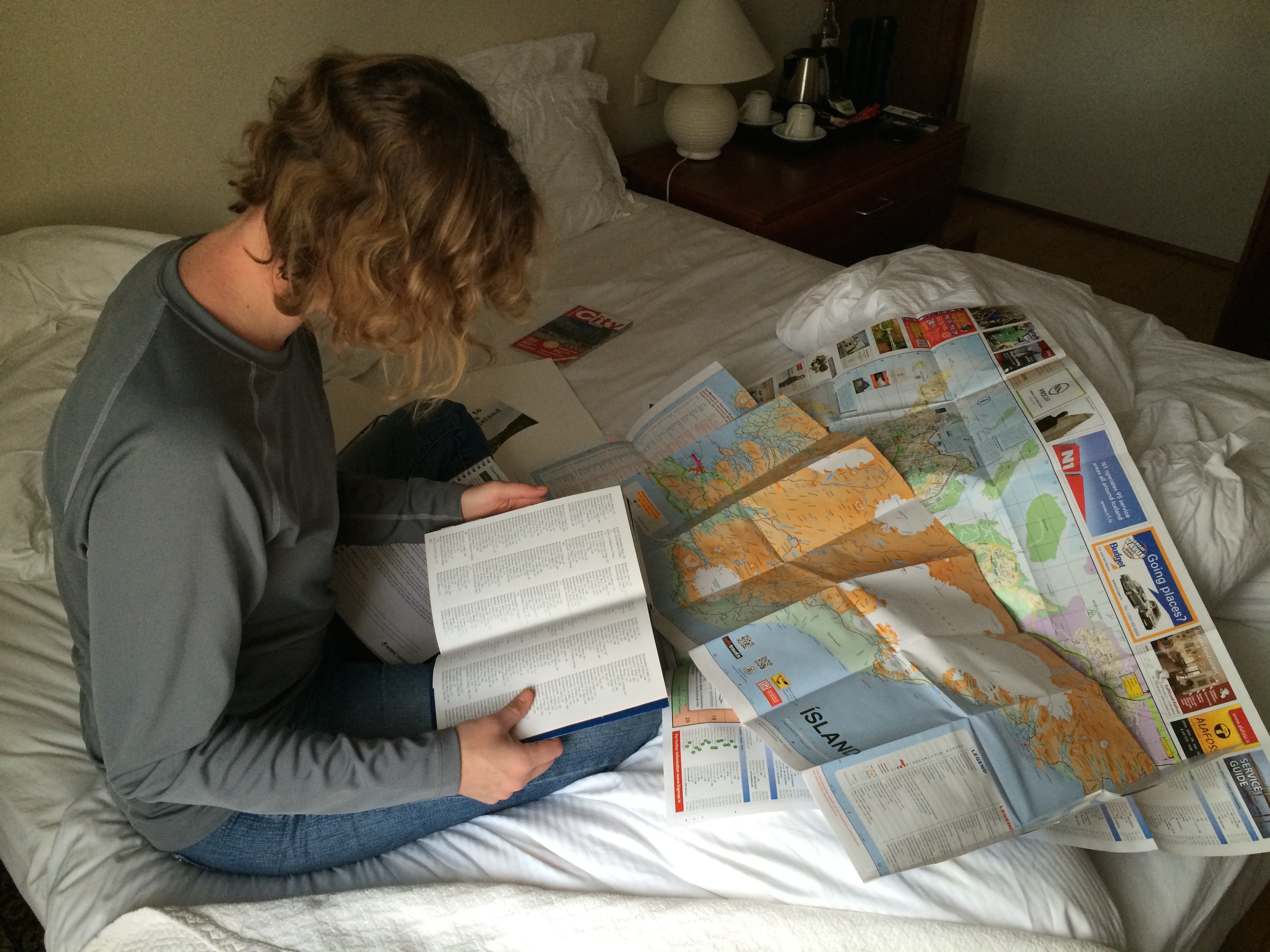
We drove about an hour or so and arrived at þingvellir National Park. We didn’t spend a lot of time wandering here as it was quite cold and windy, but the landscape and lake was quite dramatic.
Our route then led us to Geysir, one of the first documented geysers. This is actually the site where Europeans have traveled for hundreds of years to witness the natural phenomenon. We saw the Strokkur geyser erupt a few times while we were there and is the most commonly photographed (and mis-attributed) geyser in the area. The Great Geysir only erupts a few times each day.
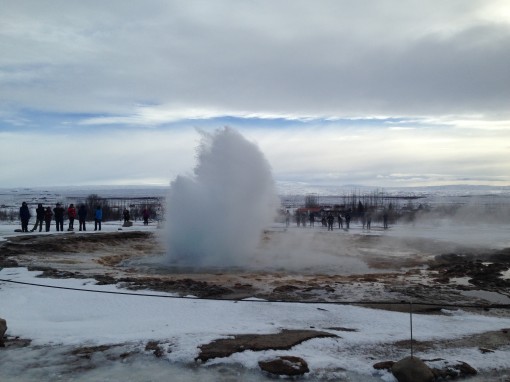
From there we continued on to Gullfoss, a huge waterfall and one of the most popular attractions in Iceland.
The cliffs drop down in two stages creating a dramatic view. We were able to hike up along side it and also down into the canyon a bit. It was so icy that the trails were actually quite dangerous.
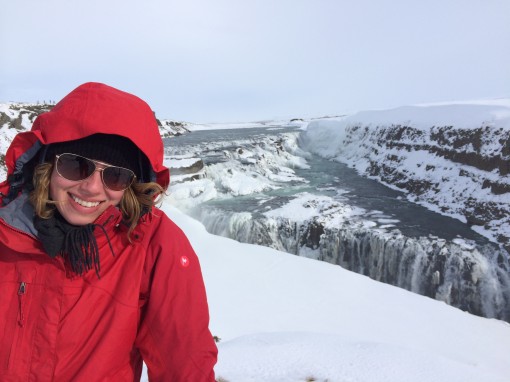
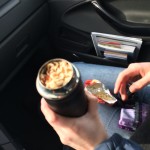 By now it was a little past lunch time and we took advantage of one of the best tips we received: in the morning fill up a thermos with hot water (its free and plentiful), stop at a gas station along the highway, buy instant noodles, and have a meal on-the-go as you sightsee. It worked out perfectly. Thanks, Sonya!
By now it was a little past lunch time and we took advantage of one of the best tips we received: in the morning fill up a thermos with hot water (its free and plentiful), stop at a gas station along the highway, buy instant noodles, and have a meal on-the-go as you sightsee. It worked out perfectly. Thanks, Sonya!
We circled down south to continue the circle and arrived at Kerið, a large volcanic crater.
It was formed after lava emptied from the chamber and the earth fall in on itself. It was an interesting sight to see and think about how it was formed.
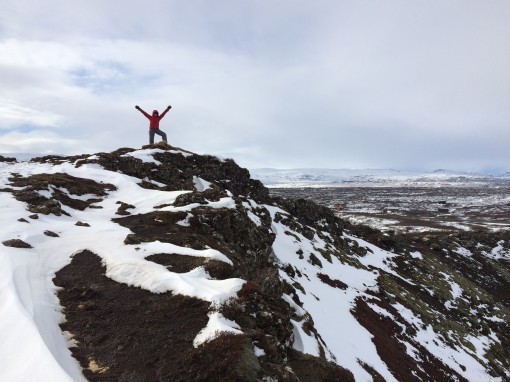
On our way back up north towards Reykjavik we noticed a lot of steam near the ocean. As we drove up and over a pass we also saw a marker for the Hellisheiði Geothermal Power Plant which had an an exhibition. We decided to take an afternoon detour and go learn about Iceland’s primary source of energy.
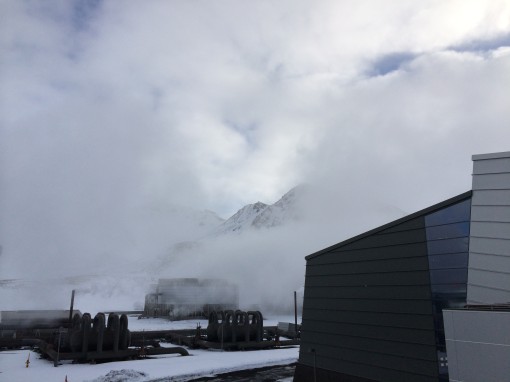
This is the newest and largest plants on the island and the facilities are awesome. The literature and exhibition itself was very informative, as well. I’d highly recommend this stop.
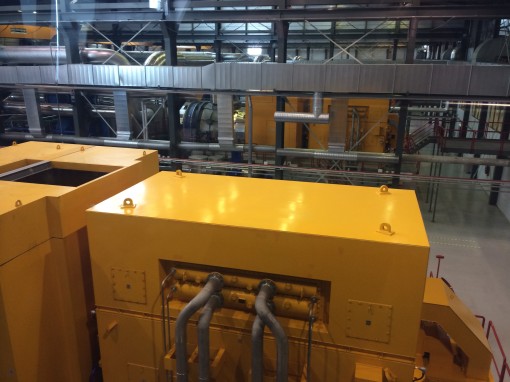
We arrived back in town and had some dinner at The Laundromat Café. We learned that, yes, even the simplest meal is going to cost us about $20 per person. On the bright side, there’s no additional tip so its worked into the cost.
That evening, around 7 PM we met up with a large tour group to head out on a northern lights trip. All said, we had about 8 large tour busses driving out into the country (actually, right back past Hellisheiði where we were just a few hours ago). The evening started out cloudy so we stayed inside at a large event hall and went outside to check every so often. The clouds started to clear and we could start to see some green cloud-like whisps over the mountains. To the naked eye the lights looked like hazy green streaks slowly moving along the sky. The weather and clouds dampened the effect but we saw them! Some folks with time-lapse cameras and tripods snagged some awesome photos. After piling back on the busses and driving back, we made it to the hotel by 1:30 AM.
March 21, 2014
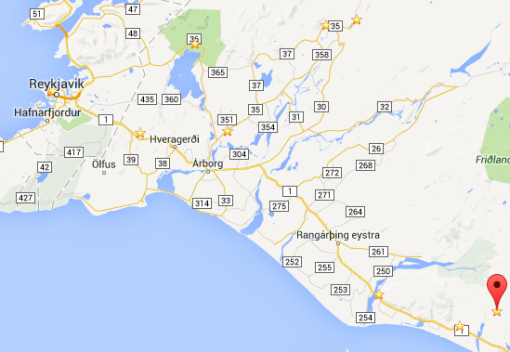
Our second “full day” had a pretty fun agenda: head south, hike a glacier, visit a waterfall, then visit another waterfall and go behind it. So, we packed our warm clothes, full ski jackets and pants, long underwear, hiking boots, YakTrax, and headed out.
We drove further south along the coast where it was warmer, but a bit windy. The drive towards the mountain range was a bit ominous but the landscape was dramatic. From the ocean the cliffs shot straight up and the wind brought snow all the way down from the peaks and volcanic range high above.
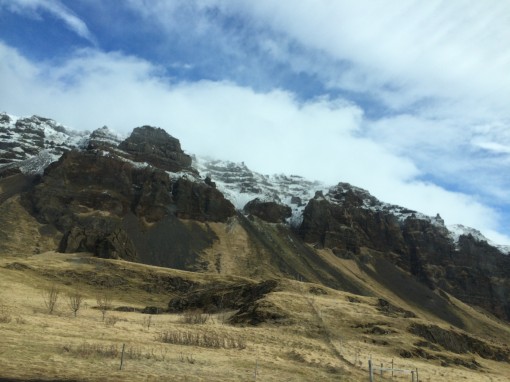
On our way to the glacier, we stopped to take a picture of Eyjafjallajökull, the volcano that erupted in 2012.
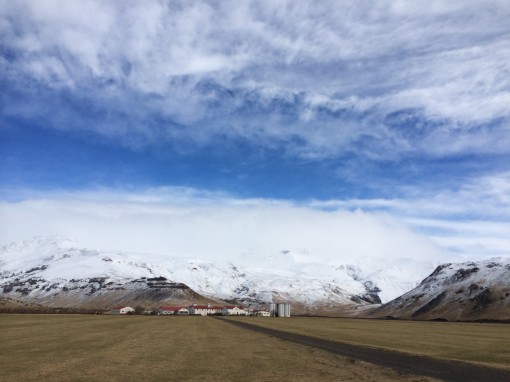
We arrived at Solheimajokull and it was extremely windy. It was coming down hard and fast from the high peaks and nearly blew us over. As we got onto the glacier we hiked with YakTrax and stayed on the paths the local tour guides use to bring groups on.
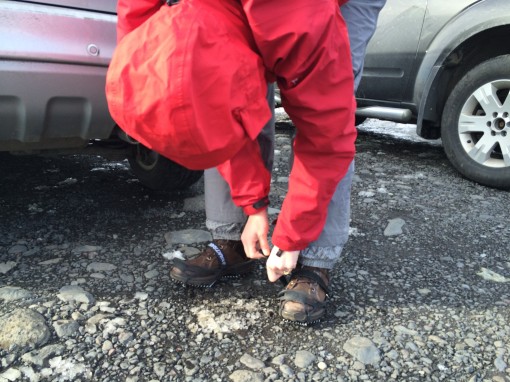
Hiking on the glacier was a fun experience. It’s such a big area of ice, it was awesome to look down and realize the canyon carved out below us, all the way to the ocean, was formed by what we were standing on.
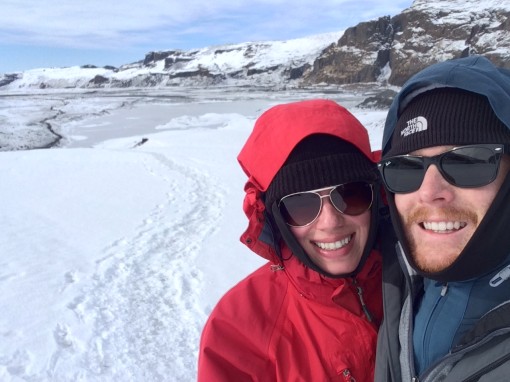
Since Solheimajokull was the furthest destination for the day, we turned back around to head back towards Reykjavik and snacked on some candy to tide us over until after our next adventures.
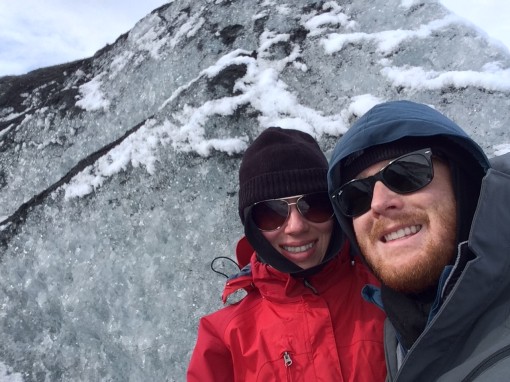
With just a few minutes of driving we arrived at the Skógafoss waterfall.
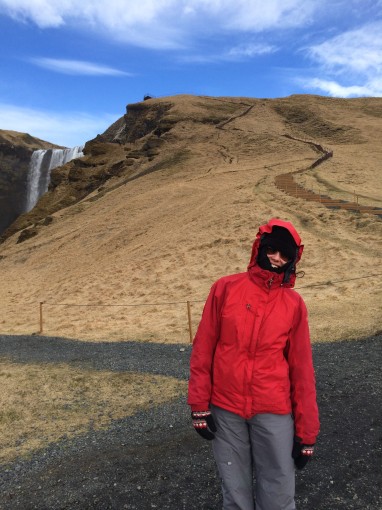
We hiked up the stairs (seen in the background) and stood high above the waterfall and ocean below.
On our way back down, we ducked off onto a dirt path that threw us right in front of the waterfall. It was a dramatic sight. We were so close to the front of the fall the mist formed icicles all around us.
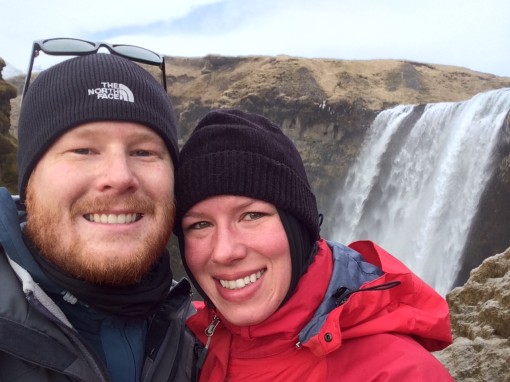
We then stood down beneath the fall. The rocks were a sheet of ice which made walking a challenge. We, and a number of other photographers, were able to snag some excellent photos, though.
Next we drove back towards the Seljalandsfoss waterfalls. Plural because the dramatic cliffs receive water from the peaks high above and the water falls off them all over the place. This specific waterfall is unique because the cave behind it has hallowed out so far back and wide you can hike up next to it and walk behind it.
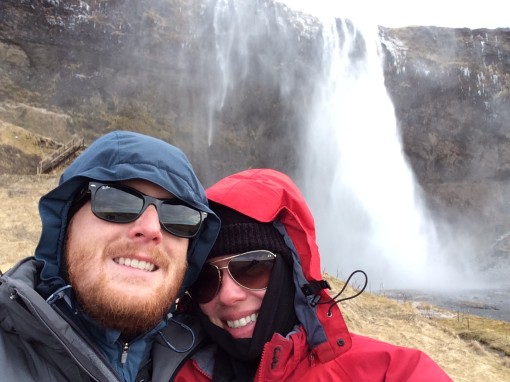
We decided to take the path less traveled and hike up beside the waterfall. The wind was so strong it literally blew the water on top of us. Instead of turning back and coming around the other side, we scurried down the rocks (again, YakTrax and waterproof jackets and pants were used here) and spent some time, quite literally, under the waterfall itself.
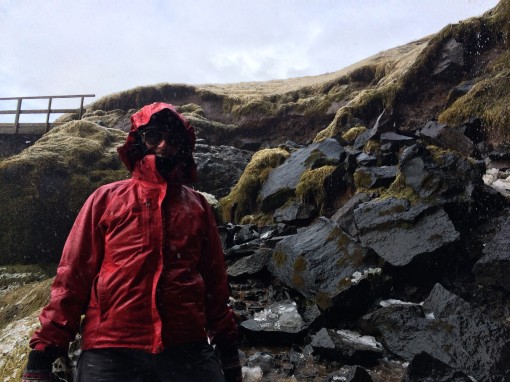
After laughing about the whole experience and being quite pleased with our adventure, we took a few photos, went back to the car, stripped down and drove off with our instant noodles in-hand.
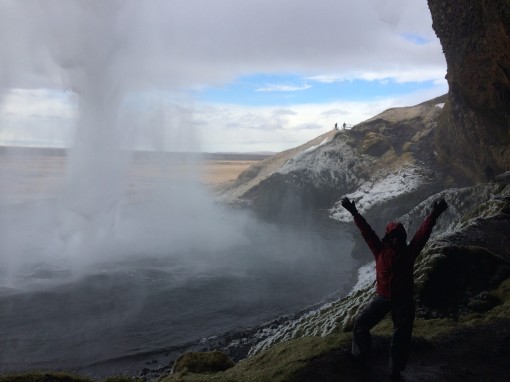
As we headed back and neared Hellisheiði again, we found ourselves in instant whiteout conditions. The dramatic passes and landscape mean you can be down on a dry road with grassy landscape and then climb a few hundred feet to be socked into a windy, snowy, cloud. Having driven over Vail Pass in Colorado, it was not unfamiliar territory. Fortunately this is quite literally one of two ways back to Reykjavik and the plows were out in full force, as well.
After putting all our clothes on all the radiators, we decided to try what seemed like a kitschy restaurant called “Lebowski Bar” for dinner. This was, as you might imagine, a bar dedicated to The Big Lebowski and specialized in hamburgers and “white russians” (in milkshake form). We actually really enjoyed it (who doesn’t love The Dude?!) and thank Sonya again for the recommendation.
March 22, 2014
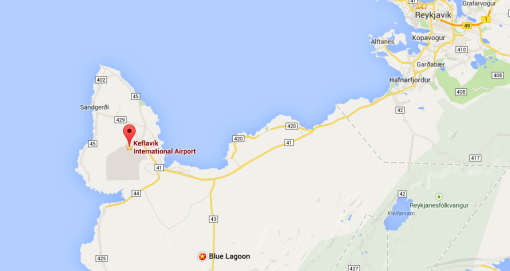
Our last day in Iceland was also a day of dramatic extremes: in-water massages at Blue Lagoon and trying to buy gas at a gas station. These two were the least stressful to most stressful things I think we encountered in the whole trip.
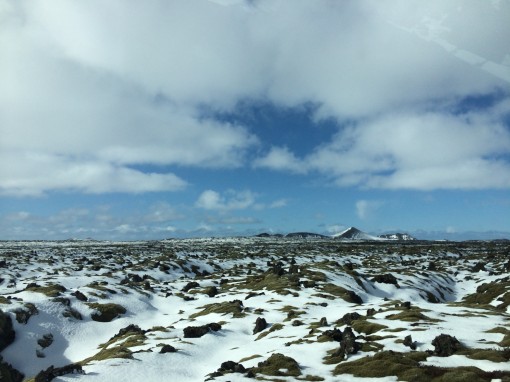
As we left our hotel and drove back towards the airport in the morning we stopped at Blue Lagoon as we had a 1 PM in-water massage.
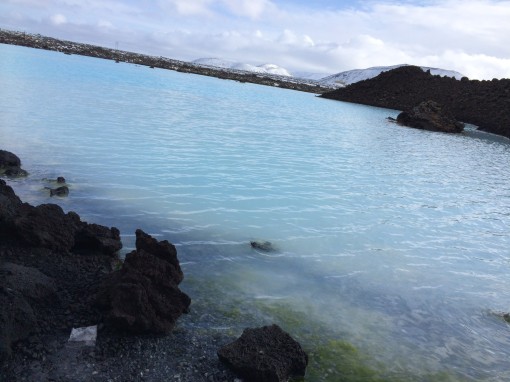
The Blue Lagoon (Bláa lónið) is truly blue because of bacteria in the water that reflect the color blue. It was fairly surreal. The land also produces silica mud which, when applied to your face, has some sort of benefit?
After our amazing in-water massages, where we laid on a foam mattress and had a warm blanket draped over us, we showered and changed into our travel clothes. We filled up the rental car with gas (kinda, what a struggle) and dropped it off at the airport. We saw that a direct flight back to Denver was leaving around the same time so we saw what it would cost to change our flight. The answer was $2,000.
We flew back to Boston and landed around 6:30 PM. Nothing says “screw you” like going through US Border Patrol. While I understand the need for security, I wish returning to my own country was not the least welcoming and unfriendly experience when traveling.
We checked into our hotel, ordered room service, fell asleep, then woke up a few hours later and flew home to Denver the next morning at 7 AM. After throwing bags and bags of clothes in the laundry we looked back over our photos and remembered one of the best trips we’ve had together in a while.
On February 22, 2014 I will be skiing on “Team Breck” at Hope on the Slopes in Breckenridge. Hope on the Slopes, Ski & Ride for a Cure is a fundraising event for skiers and boarders, held at ski areas around the country. Proceeds benefit the American Cancer Society (ACS), and support their mission to eliminate cancer as a major health problem through prevention, saving lives, and diminishing suffering from cancer through research, education, advocacy and service.
Cancer has affected my family and, more recently, a friend. If you’d like to donate towards my team please feel free to use this link.
The End of Chapter 1: my fond farewell to Crowd Favorite
I don’t think I’ve shared this much about “what I do for work” with many folks. So here we go…
Chapter 1: Alex King and Crowd Favorite1
I met Alex a few times at various tech events in the area (BarCamp Denver in 2006, Startup Weekend in 2007). We both became familiar with each other through these events were able to keep in touch loosely through our respective blogs (he’s always been a big deal in the WordPress industry).
When Alex moved the Crowd Favorite office to downtown Denver I asked to grab lunch since I was also working downtown. Coincidentally, he was about a year into Crowd Favorite and looking to bring in some help as the team and projects grew. I was also looking to find a great way to get into the internet industry.
I started working for Alex in July 2008 as an account manager supporting incoming requests from existing maintenance and support clients. Given my technical background, I also started working on exploring incoming projects, gathering their requirements, preparing estimates, and handing them off to our project manager. At some point along the way it made sense for me to take on and manage some of the projects myself. At that point I realized I lived and breathed the entire consulting client lifecycle: business acquisition, through project launch, and into ongoing support and maintenance.
In 2009 Charlie Hoehn asked me to share my thoughts on ‘the power of having a personal blog’ for his book “Recession-Proof Graduate” and I wrote: “I went from a no-name blogger to a trusted source, which ultimately landed my dream job.”
What I did at Crowd Favorite was a dream job and continued to be, even as the business and my role evolved. After years of practicing “do what you think is best” and then receiving immediate feedback from Alex, I felt like I really understood how he wanted to run his business. I’ve seen some folks get frustrated with receiving constant feedback on their actions (and inactions) but I saw each email from Alex as free knowledge. I tried to absorb everything and ask clarifying questions which allowed me to grow my understanding and responsibilities. My “Alex King bootcamp” was an amazing learning experience.
Having learned Alex’s ways and preferences, the business’ and industry’s technologies and processes, and mixing in my own experiences and knowledge: there became a point in 2012 where he and I felt like I had a good handle on most of the day-to-day happenings. We hired another project manager (bringing the total to three) to help with my clients and allow me to help with more of the business and take some responsibilities off of Alex.
Unfortunately, this was put to the test earlier this year when Alex had to take a sudden medical leave. To the entire team’s credit, everything at Crowd Favorite kept humming along just fine. I’d say my involvement within the organization during this period is one of the things I’m most proud of.
Chapter 2
I was part of the Crowd Favorite team and helped (and watched) it grow, change, and improve over the past five-and-a-half years. I took on a lot of responsibility in the past year or so and cemented a lot of thoughts about providing excellent client service, successful project management, selling products and services, managing a team, and even running a business (everything from negotiating contracts to hiring employees).
But now I’m looking to do some travel, learn new things, and explore different technologies and industries.
Derek Sivers, founder of CD Baby, put it succinctly: “I realized that the bigger learning and growing challenge for me was letting go, not staying on.”
Kevin Kelly also shared an interesting perspective: “Stewart Brand, who is now 69, has been arranging his life in blocks of 5 years. Five years is what he says any project worth doing will take. From moment of inception to the last good-riddance, a book, a campaign, a new job, a start-up will take 5 years to play through.” Five years is also approximately 10,000 working hours, a milestone Malcolm Gladwell touted as being requisite to becoming “great” at anything.
In the few months after deciding to move along, I had some excellent conversations and ultimately re-discovered a software company in California that I truly believe in. Next week, I will be joining the Enterprise team at GitHub and spending time traveling to and from San Francisco (more on that later).
TTFN
This is not a sudden development. I’ve actually been documenting and handing-off my involvement and responsibilities (to identify potential gaps) and explicitly sharing tacit knowledge with the Crowd Favorite team since early September.
More recently, I’ve also done my best (in addition to everyone else) to provide as much background and detail about the team, its projects, clients, philosophies and processes to the folks at VeloMedia (who recently acquired Crowd Favorite). I’m excited for the expertise and leadership these guys and gals bring to Crowd Favorite and look forward to what the future holds. They’ve asked me to continue to lend my thoughts to them and the project management team (for continuity) and I said I’d be more than happy to.
“I gotta go now. I’ve got a lotta bouncin’ to do! Hoo-hoo-hoo-hoo! T-T-F-N: ta-ta for now!”
That all said, I owe a big “thank you” to the patient clients, interesting prospects, friends of the company, and everyone else I’ve worked with these past few years. It’s been a pleasure.
Most importantly, I owe everything to the entire team at Crowd Favorite (new, old and alumni). I’ve learned a lot, enjoyed the experiences, and have you all to thank for who I am and where I am today.
I’m excited because I know there are great things coming for both myself and Crowd Favorite. If you’d like to follow along, you always find more over there at Crowd Favorite’s blog and here on my own.
- I held plenty of good jobs before I joined Crowd Favorite, but none of them truly feel like chapters in my “career story”; they were more like an Introduction. ↩

Second Annual Denver Brewery Tour Weekend
For the second year in a row, I hosted some friends from the east coast on a tour of Colorado breweries.
The long weekend begun on Thursday, November 7, 2013 and contained over two dozen check-ins at various breweries, eateries, and coffee shops around the Denver metro area (and Fort Collins).
Thursday consisted of…
- starting a late lunch at Euclid Hall, one of my favorite downtown restaurants with an excellent beer selection
- then stopping by Prost Brewing before happy hour (where a lawyer meetup was convening?)
- then Wynkoop Brewing Co. for some pre-dinner drinks
- then swung by Lucky Pie in LoDo for some pizza and, yet again, good local beer
Friday included…
- a (not early enough) start at Snooze, one of the busiest but tastiest spots for breakfast and brunch in downtown Denver
- Crema, for a quick hipster-filled caffeine pick-me-up
- a tour of the Stranahan’s distillery, some of the best whiskey made in Colorado
- then swinging by Breckenridge Brewery’s 471 Kalamath location for some unique beers
- then a stop by TRVE for some hard-core metal brews
- followed by a stop-over at Renegade Brewing to have one of my local favorites:
REDACTED - a delicious dinner at My Brother’s Bar, the oldest continually operating bar in Denver
Saturday comprised of…
- a world-class breakfast at Wooden Spoon, one of my favorite bakeries
- then a drive up to Fort Collins where we kicked the morning off with world-class coffee at Harbinger Coffee
- Equinox Brewing, a quaint brewery
- CooperSmith’s Pub & Brewing, a long-time brewery (before microbrews were trendy)
- funkwerks, one of the best, lesser-known saison specialists
- Odell, with one of the best flagstone “front yards” in town
- Hogshead Brewery, the tastiest cask-aged, English ales this side of the pond
Sunday wound down with:
- a delicious, early breakfast at Sassafras, quality southern cooking
- Crema again, for good measure
- a trip to Epic Brewing, the prettiest warehouse and tasting room in River North
- Crooked Stave at The Source, the best sour beers in the best cluster of butchers, bakers, and restaurants in River North
- Mile High Spirits, a great menu of local-made spirits
- Our Mutual Friend, with one of my favorite ‘session’ beers around
All in all, looking back at this list it was a busy weekend with a lot of quality stops along the way. If you’re in Denver, I highly recommend checking out any and all of these venues.
I can’t believe the ski season has already been in full swing for a few weeks now. To help kick the season off I authored a guest post over on the Breckenridge Blog talking about the art (science?) of snow forecasting and how snowfall is reported at Breckenridge. I plan to do a number of guest posts this season and expand some of my “snow writing”. Stay tuned…
Order Muppet in the streets, Chaos Muppet steals the sheets.
Preferred Contact Methods
Social etiquette often trails technological advances. You see it today when a group of friends are out to dinner and many are looking down at their smartphones. That’s obviously not an ideal social situation but no precise norms or allowances have been defined as the introduction of the always-connected device itself is still new.
I’ve been struggling lately with: how to locate, interact, coordinate, and communicate with people.
While at the same time balancing: timeliness of response required, perceived appropriateness of a communication method, ease of method, and sender’s and receiver’s own workflow.
Available Methods
We have a number of ways to get in touch with each other, find out whereabouts, ask questions, etc. Including, but not limited to:
- SMS / MMS / iMessage messages
- Phone call
- Video-based call
- Instant messaging
- Social network messaging
- Location-based services (Find My Friends, foursquare)
- Third-party (“tell Joe X”)
- Calendaring (share a schedule, meeting invitations)
- Chat rooms
- Portals or ticketing systems
Each of these then diverge further into personal and work versions of each, social networks each have different stated uses, and so on.
Limitations
Because of all these methods exist, there are equally as many preferences and good / bad ways to talk to, coordinate with, and function amongst fellow humans:
- Some of these methods aren’t available to individuals at all times (via a mobile device or otherwise)
- Others can be available (via an application) but may not be installed or open at the right time
- Notifications may not be fine-tuned to allow for timely responses (or disabled entirely, because of that)
- Individuals may choose unstated methods they prefer to receive at different intervals (X during the day, Y at night)
- Methods and preferences vary per person, all for good reason
So What?
I feel like I’m making this overly complicated and saying what we’re already aware of, but I want to make some points clear:
-
Timely communication (in warranted situations) may go undelivered. For example: did John get my SMS message stating I’ll be late? He’s at his desk in the office and has no mobile service and it would have been better if I sent him an email.
-
Opportunities may get overlooked entirely. similarly, if I don’t check LinkedIn but once a month but you send me a timely job prospect and then forget about it, it’s now my fault
-
The balance of power in some exchanges may favor one side (sender or receiver) if these preferences go unstated. For example, if Mary has a very busy schedule but I am more flexible, how can I take burden from her and put it on me to pick a good time or location to meet?
-
Social mistakes become easier and can strain relationships. I may send a non-important Twitter direct message to Steve late at night but his mobile phone alerts may allow it to wake up him and his wife with a vibration or noise alert.
Some of this is mitigated with better planning, but with the always-on and available nature of life (a separate discussion), expectations shift. Some can be simply stated outwardly (“I don’t check my email often, send me an SMS message when you’re going to be in town”), but as our business and personal social networks grow and preferences change this puts a burden on remembering (sometimes outdated) information.
Now all of this is to say that this is just how working with humans always has been and likely always will be. (Joe likes to chat with the neighbor on their front yards when he walks his dog, but Mary likes to call Jill and come over for tea.) But, with technology the challenges will likely grow, the consequences and challenges may as well, and is there any reason the tools we’ve created can’t also help solve the problems they’ve introduced?
For what its worth: I just experienced this trying to connect with friends (old and new) when visiting San Francisco. If I broadcast a note stating I will be in town via Twitter, I likely will get, but not guarantee, responses to arrive via Twitter (whether or not that’s either party’s preferred method of choice). Is email a better way to coordinate a days-away meal than a back-and-forth volley of messages? Should some of the conversation then move to SMS / iMessage when more immediate responses are required? Is sending messages to ask how far away you are any better than checking your location on Find My Friends?
Apply the same to business interactions: assuming email is the de-facto contact method of choice, when is it appropriate to make an introduction via a Facebook message? Which client can I send an SMS message to in order to get an immediate response (or vice versa)? Is it rude to decline a phone call conversation if you know it’d be better to hash out details through written instant messaging?
Managing Up, Down, and Sideways by Breandán Knowlton
 At the Digital PM Summit this year, I had the pleasure of sitting in a “conversation” session with a bunch of smart folks talking about “Managing Quality In Development Teams”. I could also tell one of the contributors in the corner really knew his stuff and had come from an interesting background. Little did I know, I was sitting in his session the next day titled “Managing Up, Down, and Sideways”.
At the Digital PM Summit this year, I had the pleasure of sitting in a “conversation” session with a bunch of smart folks talking about “Managing Quality In Development Teams”. I could also tell one of the contributors in the corner really knew his stuff and had come from an interesting background. Little did I know, I was sitting in his session the next day titled “Managing Up, Down, and Sideways”.
Breandán Knowlton presented a unique combination of concepts that I’ve taken home to the team (and to heart) when approaching conflicts (or really, any dialogs) with our interactive projects and clients.
I’m sure most folks have heard about “managing up”, or put simply, doing the things that will make both you and your boss (or client) happy. Pro-actively providing status updates before they ask for them, finding what their goals are and aligning your own to meet theirs, finding their values and cater your approaches to those. This all makes sense when applied smartly and is something I know I could think about more often when working with clients and stakeholders.
Knowlton’s talk on “Managing Up, Down, and Sideways” put a kind of spin on this and introduced a theory of four relational models used “to generate, interpret, coordinate, contest, plan, remember, evaluate, and think about most aspects of most social interaction in all societies.” If it’s good enough for all societies, its probably good enough (and applicable) to leading successful projects, no matter the size or shape.
I’ll summarize the four elementary models:
- Communal Sharing: you operate with common respect or values, love for the project or process, take collective responsibility towards success, etc.
- Authority Ranking: respect is geared more towards hierarchy and class structure, prestige or superiority exist here.
- Equality Matching: there is an unbalance perhaps in skills or knowledge and work to share, process exists to keep balance of opinions or efforts, respect may be more towards rules and regulations.
- Market Pricing: standards around cost-benefit come into play, efficiency and effectiveness may be measured, those measurements or ratios are viewed with social meaning.
Thinking about these models and how they can apply to project management should become clear. From here, Knowlton had us all run through an exercise:
- Think about a situation (a project) and then a conflict. From your own perception, what was your priority, what were you thinking about, talking about, experiencing, etc. (and did one of these social models apply to your thinking)?
- From others’ perspectives, what were their priorities and perspectives, (and what model may have applied to them)?
- Once you came to a resolution (it may or may not have been positive), what was the result, did you end up appealing to the same model, or did you find yourself (in hindsight) and your stakeholder(s) applying different models to the situation?
I thought about a project where we were building a complex network of applications and websites that all had to interoperate for a very large internet company. The project was to span nearly a year, had many requirements, plenty of details to review and keep track of, and we were nearing a point of getting final user acceptance and testing completed.
-
From my perspective, at this time (maybe 10 months in), a new stakeholder with new priorities was introduced into the project (as a newly hired senior executive). Some newly stated project priorities from that stakeholder meant the work to date would need to be re-evaluated and substantial new efforts (costs, time) would be required.
-
From their perspective, as an executive responsible for budgets, priorities, etc. this was a big project that didn’t meet obvious unstated goals, it had become more complex than needed to solve some immediate-term goals, and was at risk of not being a meaningful contribution to the organization.
Looking back, a lot of the work and interactions to-date appealed to the Communal Sharing model (we created this project together) but the introduction of a new stakeholder certainly appealed to Authority Ranking. Ultimately, we took the discussion to a common level (Market Pricing) and, in short, discussed the cost-benefit to undoing parts of the project (which also appealed to Authority) and we jointly decided to end the project, hand over our work performed to-date and allow them to continue in their preferred format (Equality Matching).
Thinking about a project’s various stakeholders, their perspectives outside of your way, and then applying the “Relational Models Theory” can likely both describe and allow you to overcome challenges, have more successful exchanges, or simply understand where a situation may have turned.
Virgin America Safety (Music) Video
I love everything about this music video and overall campaign for Virgin America’s safety video. The self-awareness (“for the .001% of you who have never operated a seatbelt before…”), catchiness, and entertainment value is not hard to produce but is a much more enjoyable (required) experience. My guess is other airlines aren’t doing something like this for two reasons: 1) safety is a priority and should not be relegated to a side show, and 2) it’s not the way it’s been done before.
This whole thing makes me step back and wonder why the safety and instructional videos are shown (or demonstrated) in-flight and not something all fliers should pre-qualify for1 (like a drivers license test) before getting on a plane.
- I believe Bruce Schneier or someone similar proposed this when discussing security, TSA, flying, etc. ↩

